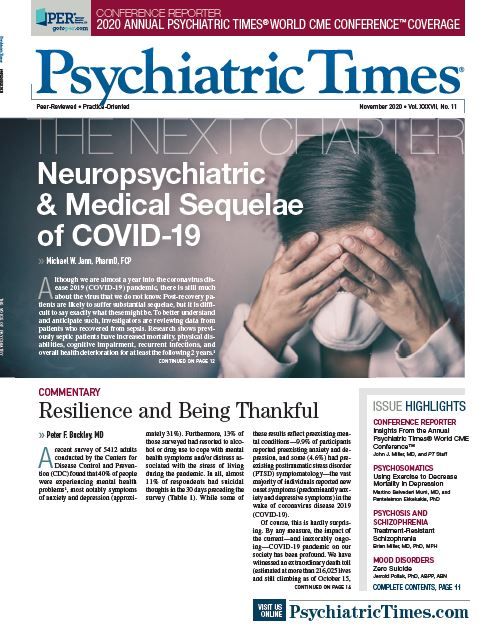Publication
Article
Psychiatric Times
Psychiatry’s Role in the Management of Chronic Pain
Author(s):
Pain may not often be considered within the realm of psychiatry; however, chronic pain's relationships with sleep disorders and PTSD make it an issue psychiatrists can—and should—address.
BillionPhotos/Shutterstock

SPECIAL REPORT: PAIN & PSYCHIATRY
If you were to poll physicians and ask which specialty usually takes the lead in the management of chronic pain, no doubt an overwhelming majority would say anesthesiology, with a smaller number saying neurology and physiatry. However, probably few would say psychiatry.
It is odd considering the recent revision of the definition of pain by the International Association for the Study of Pain, the leading worldwide organization for medical professionals involved in the field of pain: “Pain is always a subjective experience that is influenced to varying degrees by biological, psychological, and social factors.”1 This appears to be almost precisely with what psychiatry deals.
We already know that there is a high degree of comorbidity between depressive and anxiety disorders with chronic pain and, although it is commonly thought that the mental disorders are always secondary to the pain, research has shown that pain is a common presenting symptom of these disorders.
The papers in this Special Report discuss 2 other problems that frequently occur in those with chronic pain: sleep disorders and posttraumatic stress disorder (PTSD). We have known about the relationship between sleep disorders and chronic pain for years; however, the relationship between pain and PTSD is a more recent finding.
Sleep disorders
As with depressive and anxiety disorders, it is usually thought that if a sleep disorder is present in a person with chronic pain, the sleep issue is always secondary to the pain. However, this oversimplifies the relationship. The interaction between pain and sleep disorders is often a 2-way street, with each exacerbating the other. Both the pain and the sleep disorder need to be addressed.
Of course, the presence of any type of pain can impair sleep. Patients with peripheral diabetic neuropathic pain often report worse pain in their lower extremities during the night when they are trying to sleep. Those who suffer from complex regional pain syndrome in their lower extremities may complain that it is it painful to have sheets touch their skin due to allodynia, in which stimuli that do not usually cause pain do so. Patients with back pain often report problems with sleep due to pain although, curiously, laying down is the position they usually find most comfortable. In fact, if the pain is worse lying down, it is considered a red flag indicative of serious underlying pathology.
Similarly, disruption in normal sleep cycles can cause pain. More than 45 years ago, research found disruptive sleep in some healthy individuals precipitated the symptoms of fibromyalgia and resulted in widespread pain.2
There are few studies on the treatment of comorbid pain and sleep disorders. Although both are commonly treated with medications, there is limited research on using pharmacologic agents when both problems are present. Most of the studies have looked at pregabalin in patients with fibromyalgia.3
Opioids and benzodiazepines, medications that are frequently prescribed for patients with chronic pain, may actually exacerbate pain because they can cause hyperalgesia (eg, lower pain threshold). These agents can also exacerbate sleep disorders because of their disruption of normal sleep architecture. Sadly, many lay people and medical professionals mistakenly believe that the sedative side effects of these medications mean they will be beneficial for sleep.
PTSD
There is much less research on chronic pain and PTSD, although there has been a growing interest in the past few years.
A limiting factor of the data is that much of the research involves veterans. Due to the nature of our recent wars, many veterans suffer from painful injuries caused by explosions. They frequently suffer from traumatic brain injuries (TBI) of varying severity. In fact, both pain and sleep disorders have both been associated with TBI.4 Of course, few civilians who suffer PTSD have similar experiences, so the role TBI may play in the development of comorbid PTSD and chronic pain remains to be determined.
In addition, research has shown that PTSD may not only be associated with both pain and sleep disorders, but also play a role in acute pain becoming chronic pain.5
Since we have yet to identify a markedly efficacious treatment for PTSD, adding chronic pain as a factor further complicates care decisions. Furthermore, although there has been much speculation as to which factors predispose people to develop PTSD and chronic pain separately, we still have no final answer, and we have limited ability to predict who is at increased likelihood for developing both.
For all 3 problems—PTSD, sleep disorders, and chronic pain—psychologically based therapies appear to be among the most promising treatments. They also do not carry the same risks of exacerbating another condition as do medications.
Since psychiatrists often treat PTSD and even sleep, there is little doubt they will see patients with comorbid chronic pain. Unless psychiatrists also are knowledgeable about pain and its management, we will not be able to provide optimal care for our patients.
Dr King is in private practice in Philadelphia.
This article was originally posted on October 21, 2020, and has since been updated. Scroll down for the PDF of the full print issue in which it appeared. -Ed
References
1. Raja SN, Carr DB, Cohen M, et al. The revised International Association for the Study of Pain definition of pain: concepts, challenges, and compromises. Pain. 2020;161:1976-1982.
2. Moldofsky H, Scarisbrick P, England R, et al. Musculoskeletal symptoms and non-REM sleep disturbance in patients with “fibrositis syndrome” and health subjects. Psychosom Med. 1975;37:341-351.
3. Husak AK, Bair MJ. Chronic pain and sleep disturbances: a pragmatic review of their relationships, comorbidities, and treatments. Pain Medicine. 2020;21:1142-1152.
4. Lavigne G, Khoury S, Chauny JM, et al. Pain and sleep in post-concussion/mild traumatic brain injury. Pain.2015;156(supp.1):S75-S85.
5. Burns JW, Janssen, Lillis T, et al. The transition from acute to persistent pain: the identification of distinct trajectories among women presenting to an emergency department. Pain. 2020.






